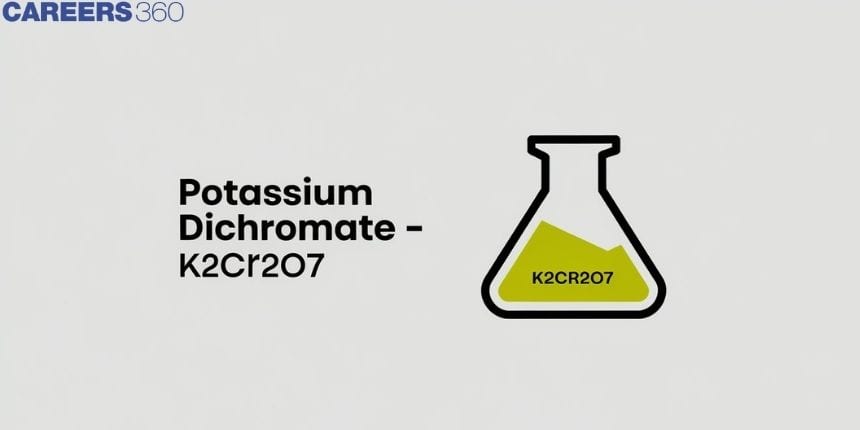K2Cr2O7 (Potassium dichromate): Structure, Molecular Mass, Properties and Uses
K2Cr2O7 is an organic chemical reagent with the chemical name Potassium dichromate. It is also called Potassium bichromate. It is a crystalline ionic solid, with a bright red-orange colour. It is odorless and insoluble in acetone and alcohol but dissolves in water. It is widely used as a precursor to potassium chrome alum and leather tanning.
- Potassium Dichromate - K2Cr2O7-
- Some Solved Examples
- Conclusion

Potassium dichromate is known to form an analytical reagent known as Schwerter’s solution when it is dissolved in 35% nitric acid solution. This reagent can be used to test for the presence of different metals, especially for silver purity determination. Pure silver is known to impart a dark red color. Potassium dichromate primarily affects the respiratory tract which causes ulcerations. K2Cr2O7 is a known human carcinogen with an increased risk of developing lung cancer. Toxic effects can result from accidental ingestion of the material, animal experiments show that ingestion of fewer than 40 grams can be deadly or cause severe harm to the individual’s health.
Potassium Dichromate - K2Cr2O7-
Potassium dichromate is a very important chemical used in the leather industry and as an oxidant for the preparation of many azo compounds. Dichromates are generally prepared from chromate, which in turn are obtained by the fusion of chromite ore (FeCr2O4) with sodium or potassium carbonate in free access of air. The reaction with sodium carbonate occurs as follows:
4FeCr2O4+8Na2CO3+7O2→8Na2CrO4+2Fe2O3+8CO2
The yellow solution of sodium chromate is filtered and acidified with sulphuric acid to give a solution from which orange sodium dichromate, Na2Cr2O7.2H2O can be crystallized.
2Na2CrO4+2H+→Na2Cr2O7+2Na++H2O
Sodium dichromate is more soluble than potassium dichromate. The latter is, therefore, prepared by treating the solution of sodium dichromate with potassium chloride.
Na2Cr2O7+2KCl→K2Cr2O7+2NaCl
Orange crystals of potassium dichromate crystallize out. The chromates and dichromates are interconvertible in an aqueous solution depending upon the pH of the solution. The oxidation state of chromium in chromate and dichromate is the same.
2CrO42−+2H+→Cr2O72−+H2O+Cr2O72−+2OH−→2CrO42−+H2O
The structures of the chromate ion, CrO42– and the dichromate ion, Cr2O72– are shown below. The chromate ion is tetrahedral whereas the dichromate ion consists of two tetrahedra sharing one corner with Cr–O–Cr bond angle of 126°. Sodium and potassium dichromates are strong oxidizing agents; sodium salt has a greater solubility in water and is extensively used as an oxidizing agent in organic chemistry. Potassium dichromate is used as a primary standard in volumetric analysis. In an acidic solution, its oxidizing action can be represented as follows:
Cr2O72−+14H++6e−→2Cr3++7H2O
Thus, acidified potassium dichromate will oxidize iodides to iodine, sulfides to sulfur, tin(II) to tin(IV), and iron(II) salts to iron(III). The half-reactions are noted below:
6I→3I2+6e−+3H2 S→6H++3S+6e− +3Sn2+→3Sn4++6e−+6Fe2+→6Fe3++6e−
The full ionic equation may be obtained by adding the half-reaction for potassium dichromate to the half-reaction for the reducing agent, for e.g.,
Cr2O72−+14H++6Fe2+→2Cr3++6Fe3++7H2O
Recommended topic video on(Potassium Dichromate - K2Cr2O7)
Some Solved Examples
Q.1 Which of the following compounds is formed when a mixture of K2Cr2O7 and NaCl is heated with conc. H2SO4?
1) CrO2Cl2
2) CrCl2
3) Cr2(SO4)3
4) Na2CrO4
Solution-
As we learned,
In the Chromyl chloride test for detecting Chloride ions, orange-red fumes of Chromyl chloride are formed when any ionic chloride like NaCl is allowed to react with K2Cr2O7 in the presence of H2SO4. The reaction is given as
K2Cr2O7+4NaCl+6H2SO4→2KHSO4+4NaHSO4+2CrO2Cl2+3H2O
Hence, the answer is the option (1).
Q.2 When SO2 is passed through acidified K2Cr2O7 solution-
1) the solution turns blue
2) the solution is decolourised
3) SO2 is reduced.
4) green Cr2(SO4)3 is formed
Solution:
As we learned,
In the Chromyl chloride test for detecting Chloride ions, orange-red fumes of Chromyl chloride are formed when any ionic chloride like NaCl is allowed to react with K2Cr2O7 in the presence of H2SO4. The reaction is given as
K2Cr2O7+4NaCl+6H2SO4→2KHSO4+4NaHSO4+2CrO2Cl2+3H2O
Hence, the answer is the option (1).
Conclusion
Potassium dichromate is a chemical compound that has significant industrial and laboratory applications due to its oxidizing properties. It is commonly used in laboratories for oxidation reactions, as a cleaning agent for glassware, and in the preparation of various chromium compounds. However, potassium dichromate is highly toxic and carcinogenic, requiring careful handling and disposal to prevent environmental contamination and health hazards.
Also Read
11 Mar'25 07:18 PM
11 Mar'25 07:09 PM
17 Oct'24 05:14 PM
17 Oct'24 04:50 PM
30 Sep'24 11:29 AM
30 Sep'24 08:51 AM
21 Jul'22 03:42 PM
21 Jul'22 02:44 PM
20 Jul'22 05:01 PM